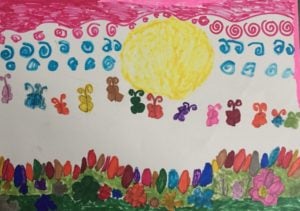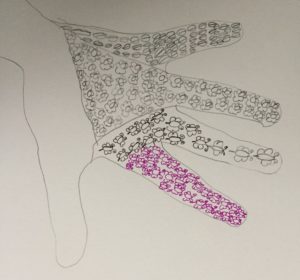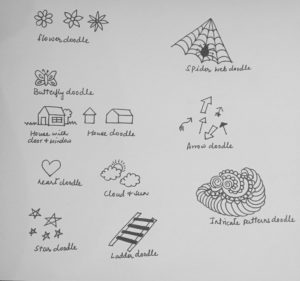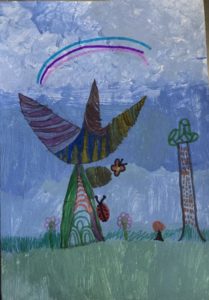Written by SENsational Tutors Ltd You can register for FREE on our website here
How can doodle art boost creativity and relieve anxiety in children?

Most of us have had experience of doodling, whether as a child or in adulthood. But what is doodle art and how can it help an anxious child?
What is doodle art?
Doodle art happens when a thought from our unconscious self comes out as a drawing of a shape or sketch. It’s an art form that doesn’t involve much of our conscious mind. If a little more thought or effort is put into a drawing though, a child can create an artwork that can be interpreted, just like a language.
Doodle art is a practice I teach which can help your child to communicate his or her emotions or thoughts in this visual language and release stress. It’s simple to do, because it is representational, based on an icon or a basic shape. It can really boost a child’s creativity and also reduce his or her anxiety levels.
The types of shapes or images your child may draw when he or she is doodling can often represent subconscious thoughts or feelings.
A doodle art workshop can help your child to to put these thoughts on paper, helping them to be more mindful. The act of drawing itself can help to relax their mind.
Doodling for stress relief:
3 big benefits of doodle art
It helps improve memory and concentration
Doodling helps the brain to stay alert for a long period and, as a result, process more information than it would if a person wasn’t doodling.
If a person needs to listen or pay attention to something for a long period of time, the brain tends to ‘switch off’. Doodling prevents this from happening by engaging the brain without the person losing interest.
A study by the University of Plymouth backs up this idea. Study participants were asked to listen to a dull telephone message and then to recall the information afterwards. Half the participants were asked to shade in some squares and circles while listening to the message. They were told not to bother with neatness or keeping within the lines – so this was just like doodling!
These doodlers were far better at recalling the information from the call afterwards than the non-doodlers. The likely reason for this is because they were keeping their brains engaged at just the right level of arousal, stopping their minds going into a ‘daydream’ default brain state.
It boosts creativity
Research has shown that doodling or art-making tasks can help our creativity. A Drexel University study measured blood flow to the prefrontal cortex area of the brain using fNIRS (functional near-infrared spectroscopy). This study considered three types of drawing; doodling around a pre-drawn circle, colouring in a mandala, and free drawing on a blank sheet of paper. It concluded that “even a short series of creative self-expression or art-making tasks completed in approximately 15–20 minutes can result in individuals perceiving themselves as having good ideas and being able to solve problems.”
It helps express emotions and relieves anxiety
Dr Robert Burns, a former director of the Institute for Human Development at the University of Seattle, has used doodles to diagnose emotional issues and stated that “even the most innocent doodle may carry messages from the unconscious”. He believes that, in the same way that an EEG transmits brain activity to a piece of paper, your hand also does the same when you’re doodling.
Encouraging your child to doodle, especially in the type of supervised doodle art workshops I teach, can help to release these locked in emotions or anxieties.
One of the amazing benefits of doodling is its ability keep you focused on the here and now. Doodling helps you feel more ‘zen’ because it’s so simple and effortless.
What do the different shapes or images we doodle mean?

It’s not an exact science but many of the common shapes or images we tend to doodle are thought to have certain meanings.
Here are just some doodle shapes and what they are thought to mean.

Flowers: creativity or femininity. Rounded petals suggest a family-orientated person, pointy petals can indicate someone with a warm heart but is defensive
Butterflies or bees: someone who doesn’t want to be tied-down or face a difficult challenge
Emotional people who want harmony and love tend to draw things with circular or rounded shapes, or symbols of love and femininity (circles, spirals, suns, flowers, hearts, faces, lips, eyes, small animals, cups, jugs, balloons, rings, wheels, shoes, clocks, loops, fluffy clouds, rounded trees, hills, fruit, waves).
Down-to-earth, practical people who need security and like to be in control tend to draw things with square shapes or flat surfaces, or symbols of material security (squares, boxes, houses, doors, windows, walls, fences, ladders, stairs, tables, chairs, chessboards, books, forts, towers, fireplaces, money, numbers, block letters, punctuation marks).
Tips to help encourage your child to doodle at home
- Give your child some free mind time to let their thoughts wander.
- Don’t impose your thoughts on them.
- Don’t judge their drawings.
- After they have finished doodling, talk about their idea or the thought behind it.
- Encourage your child to doodle different faces in one after another.
- Before going to bed let your child draw their day or just a few patterns.
- Help your child to become aware of his or her senses. This will help them to express themselves well visually.
- One easy way to get started is to use shapes to create an artwork.
- Encourage your child to do both composition-based doodles and pattern-based doodles.
Doodle art will help your child to face the challenges of their day with ease, happiness and joy.
Need more help so your child can enjoy the mindful benefits of doodle art?
To Book a workshop: Contact Us
SENsational Tutors!
At SENsational Tutors Ltd, we aim to inspire a love of learning through fun and exciting activities. We offer tailor-made support packages during the school holidays and on regular, weekly basis. Sessions can be combined with additional behaviour or communication support, if necessary.
Register here to receive information about our services, including our FREE webinars!
Contact us here





